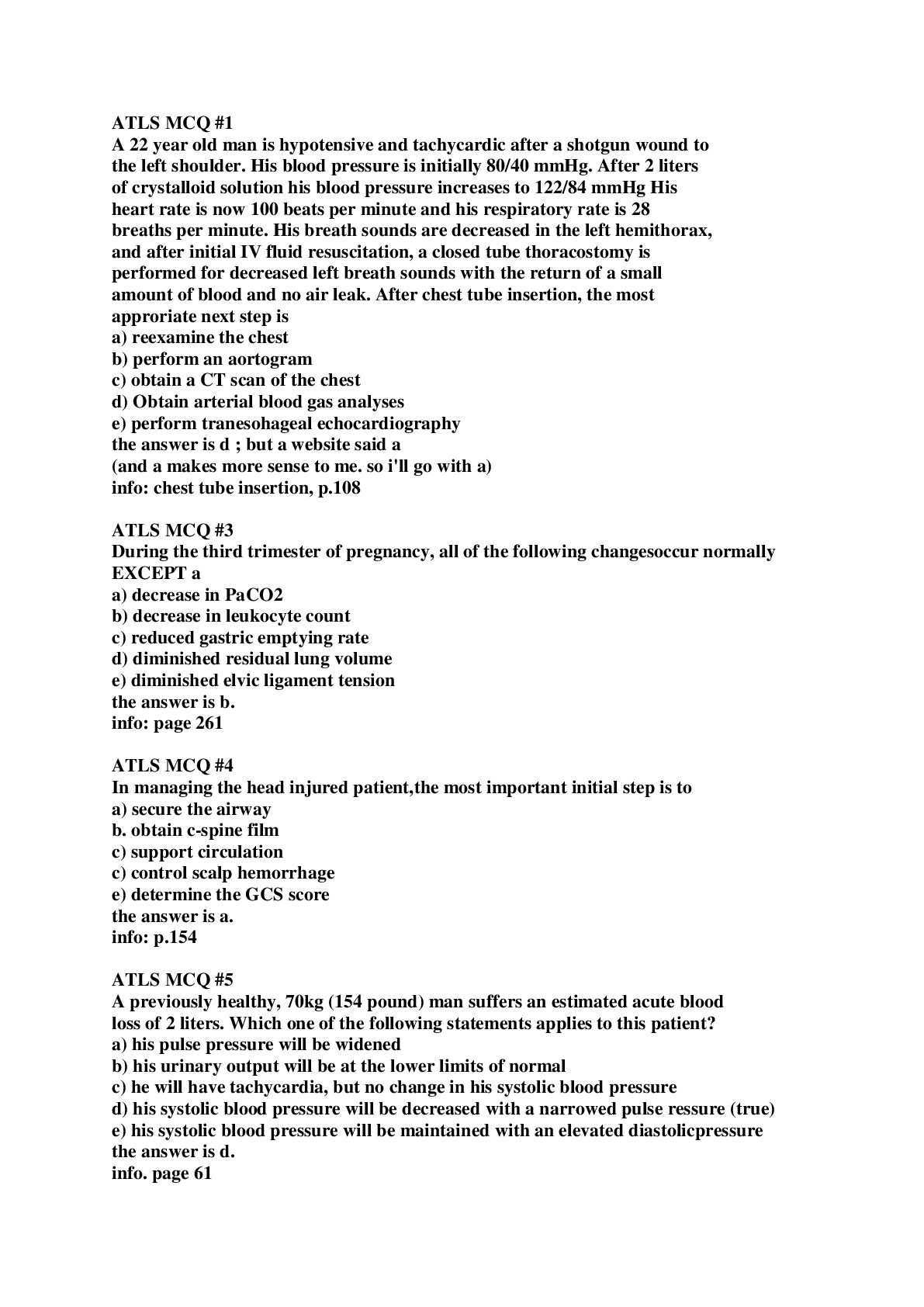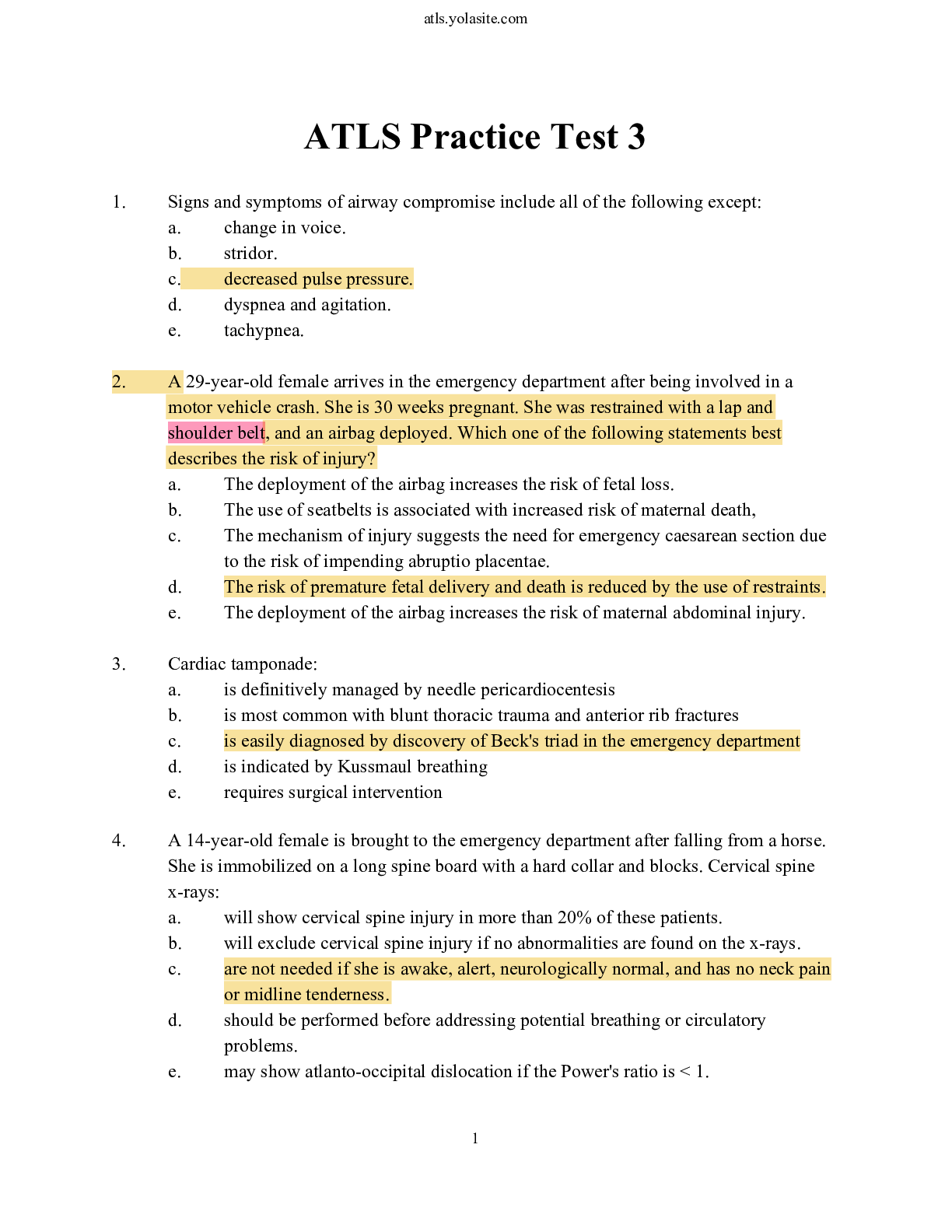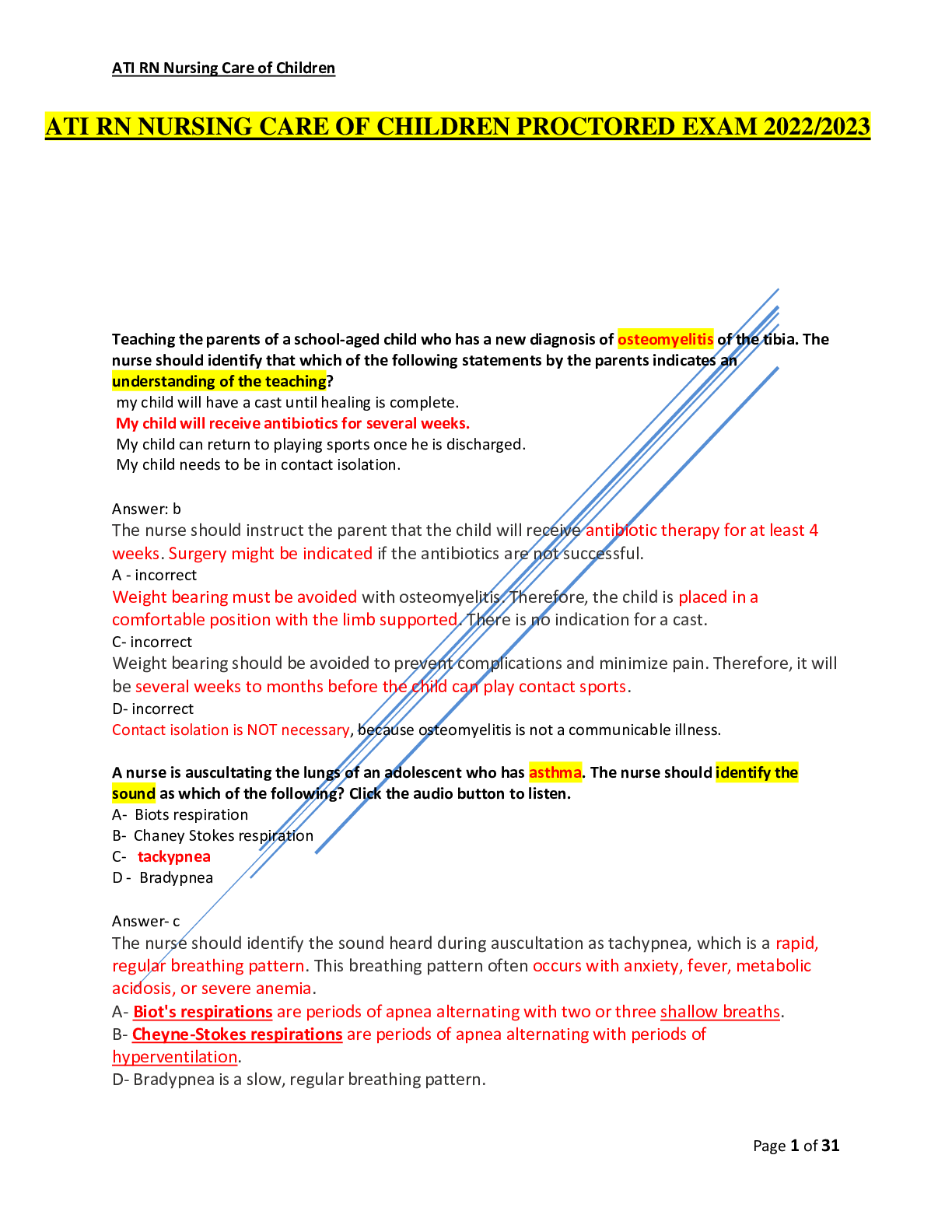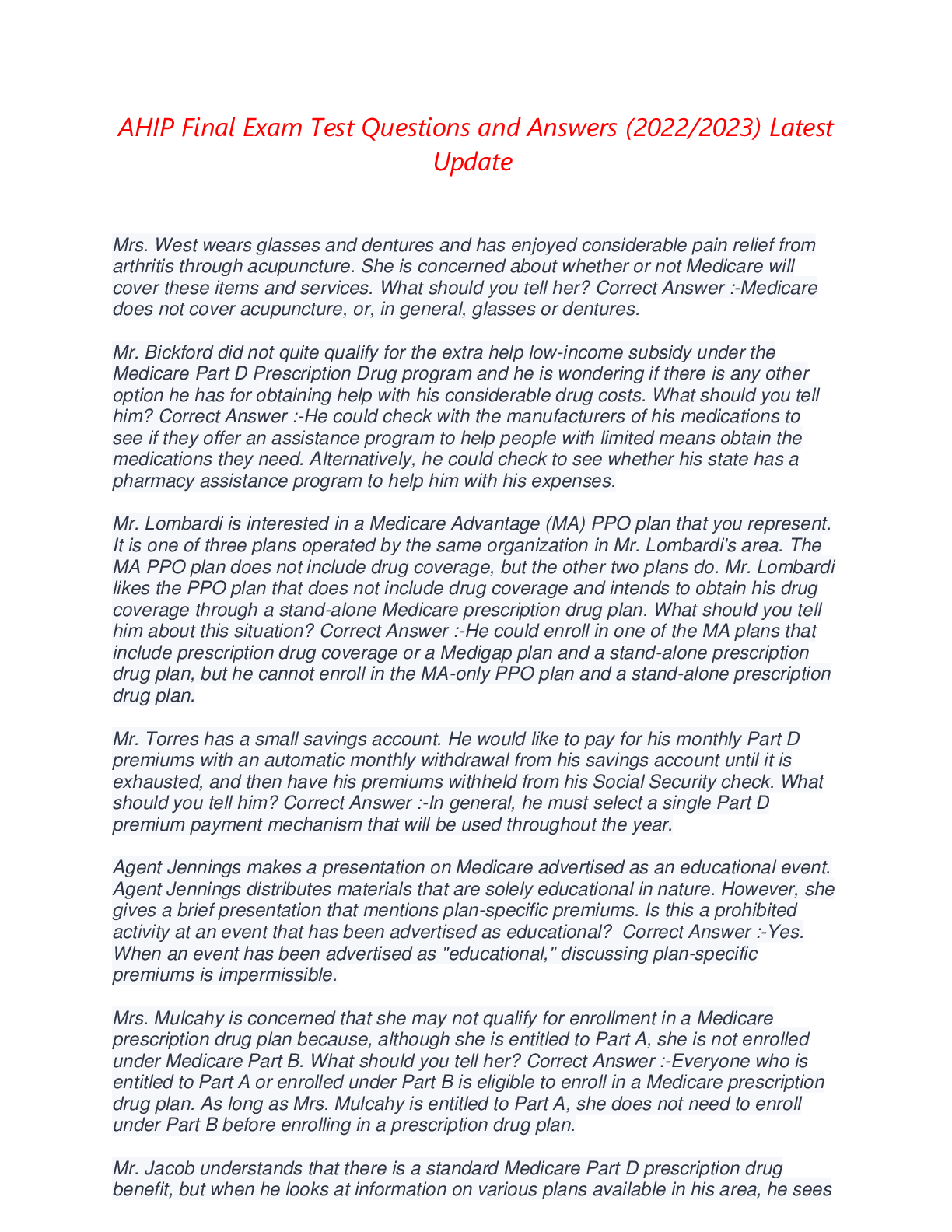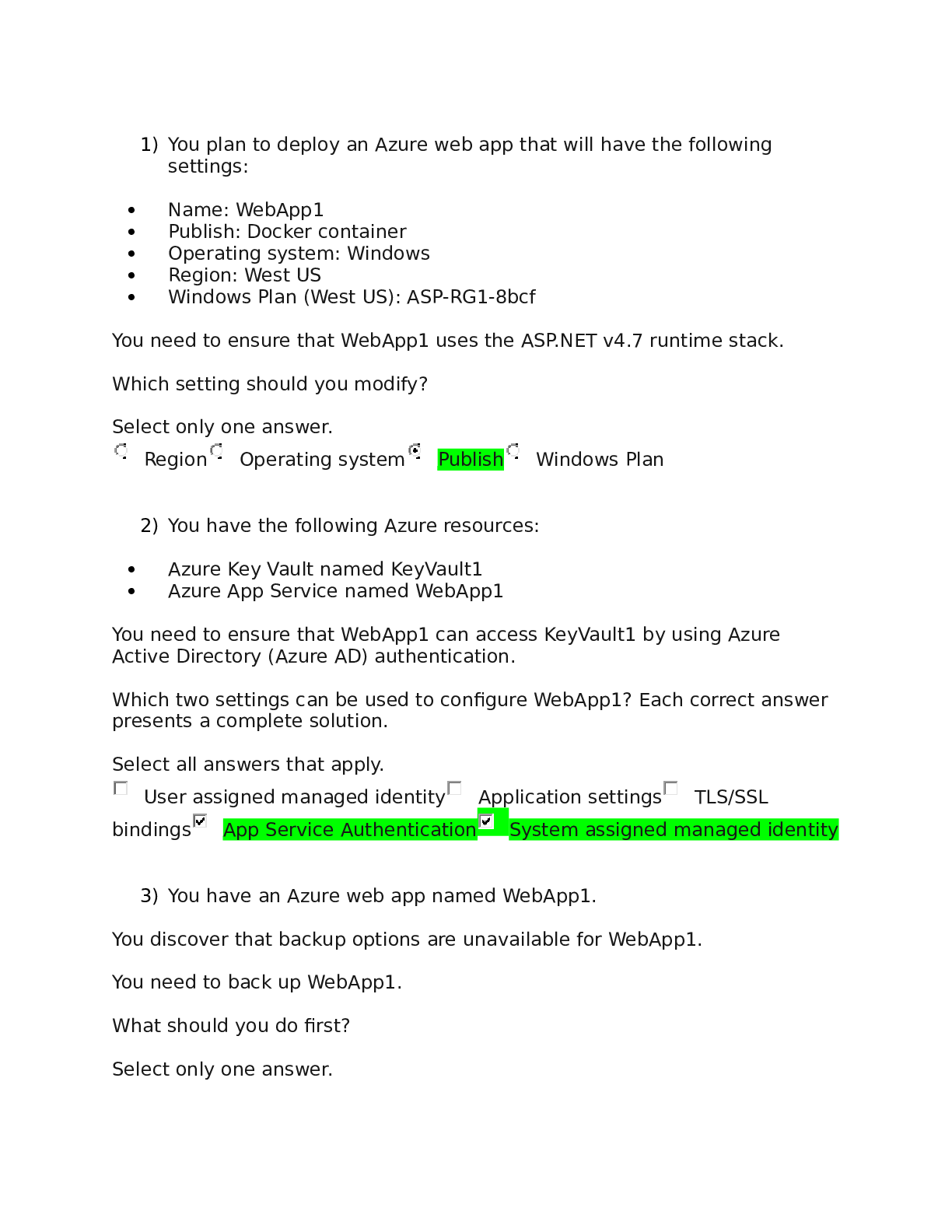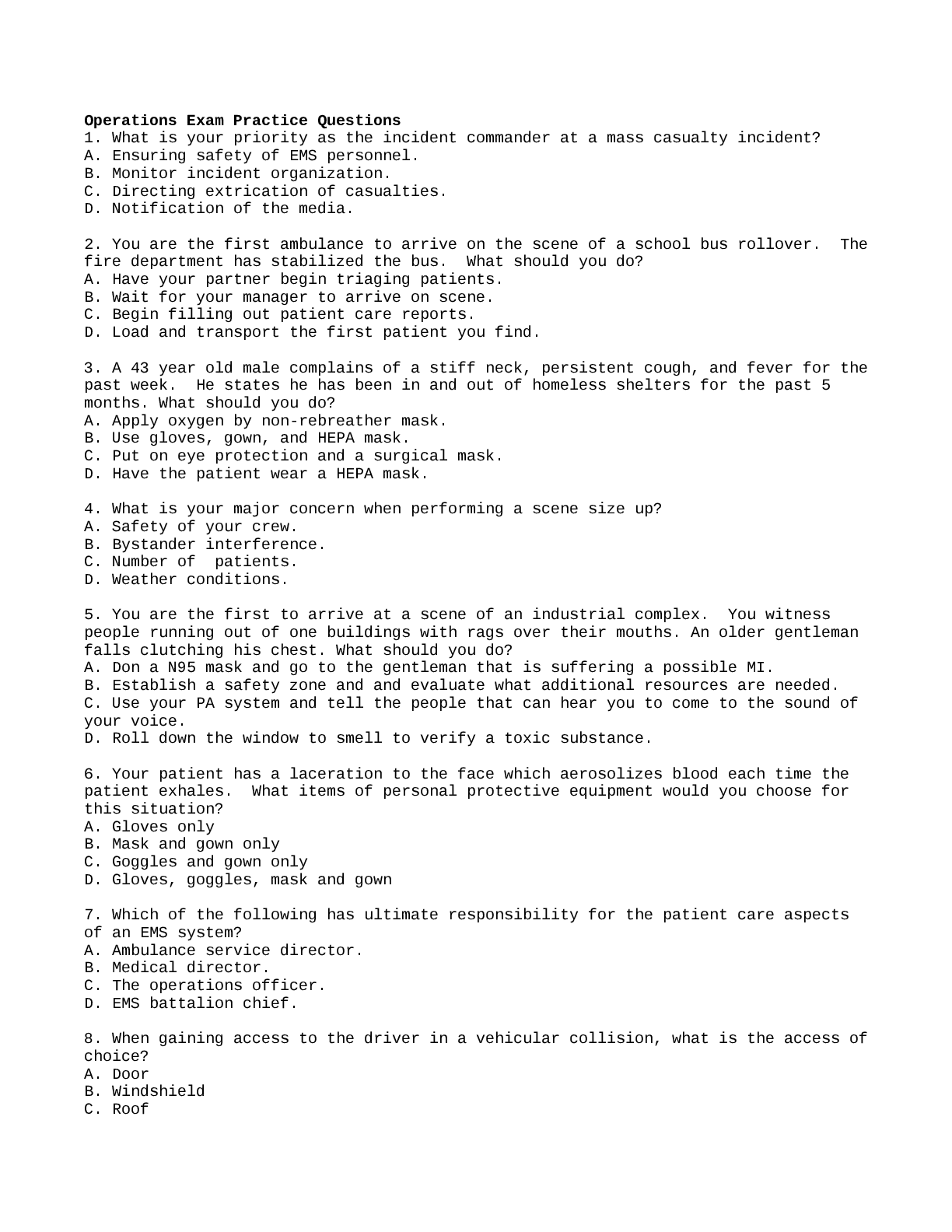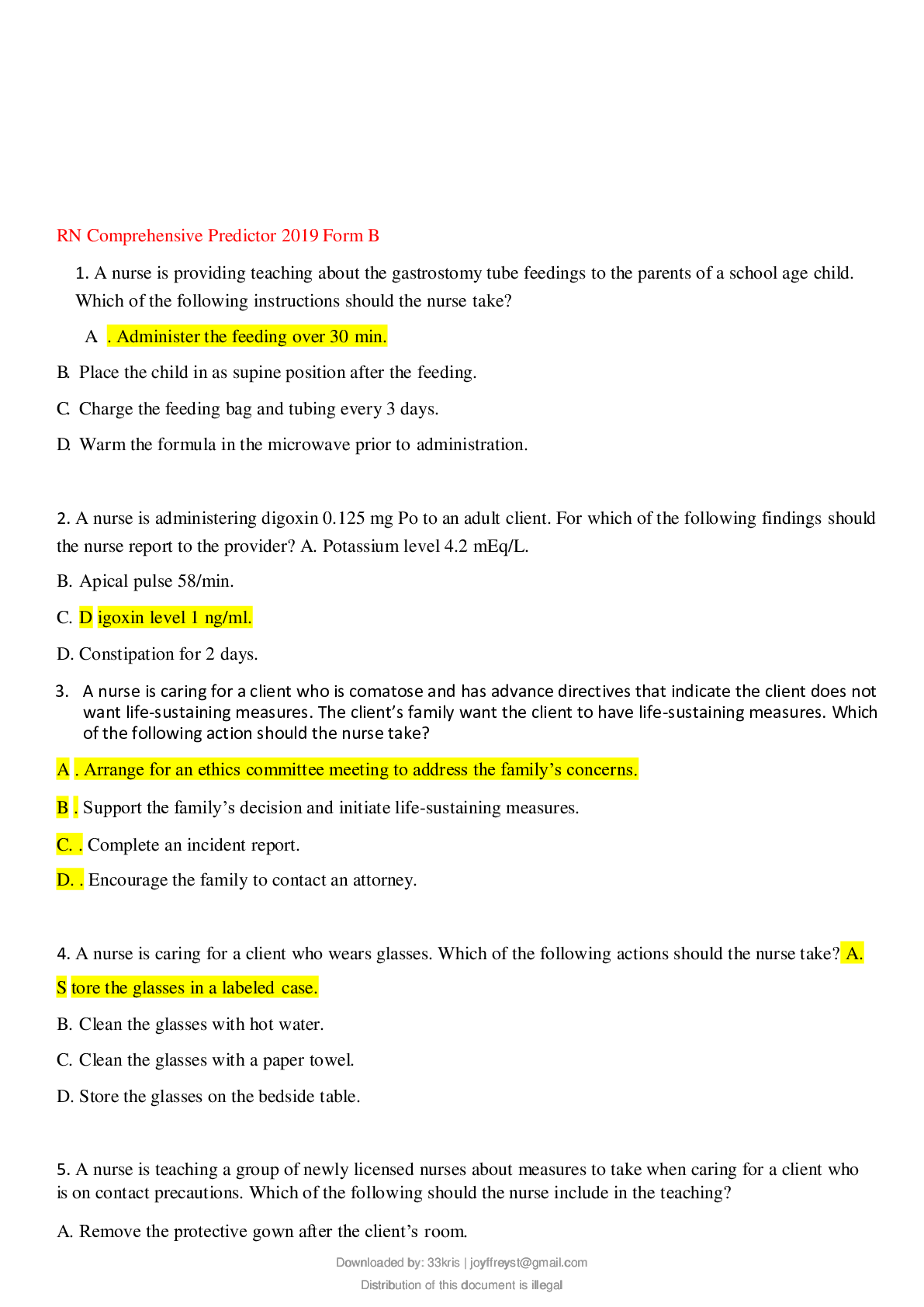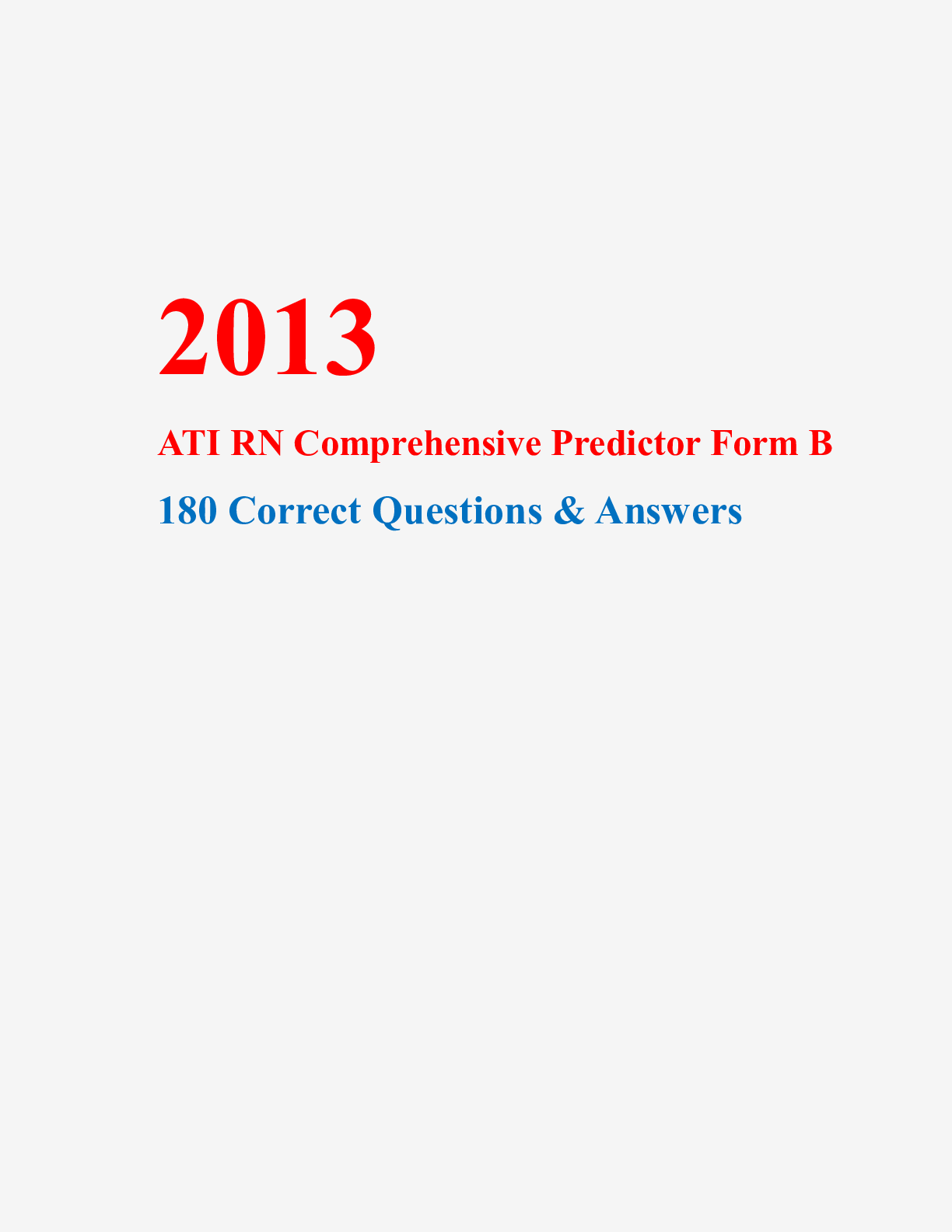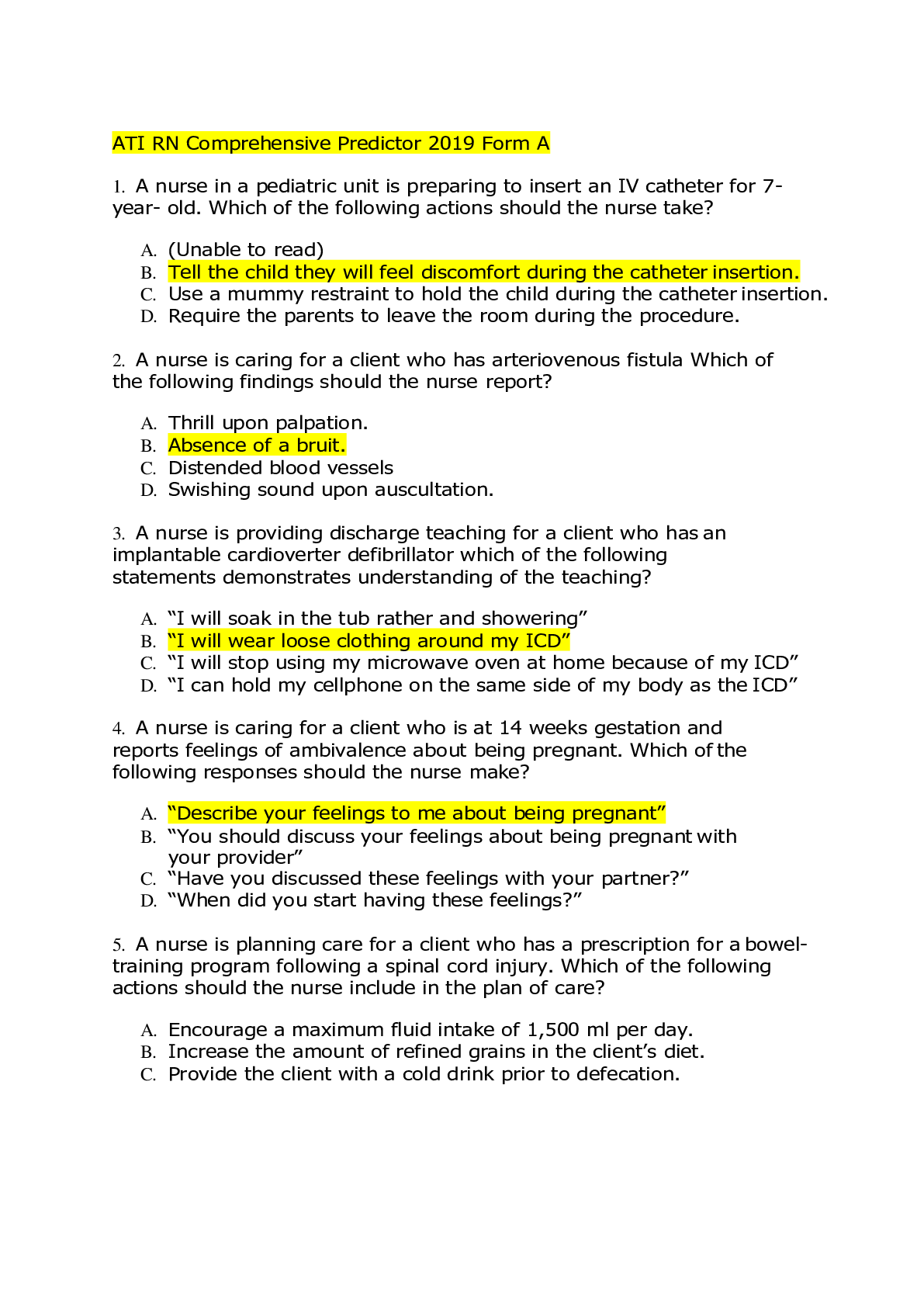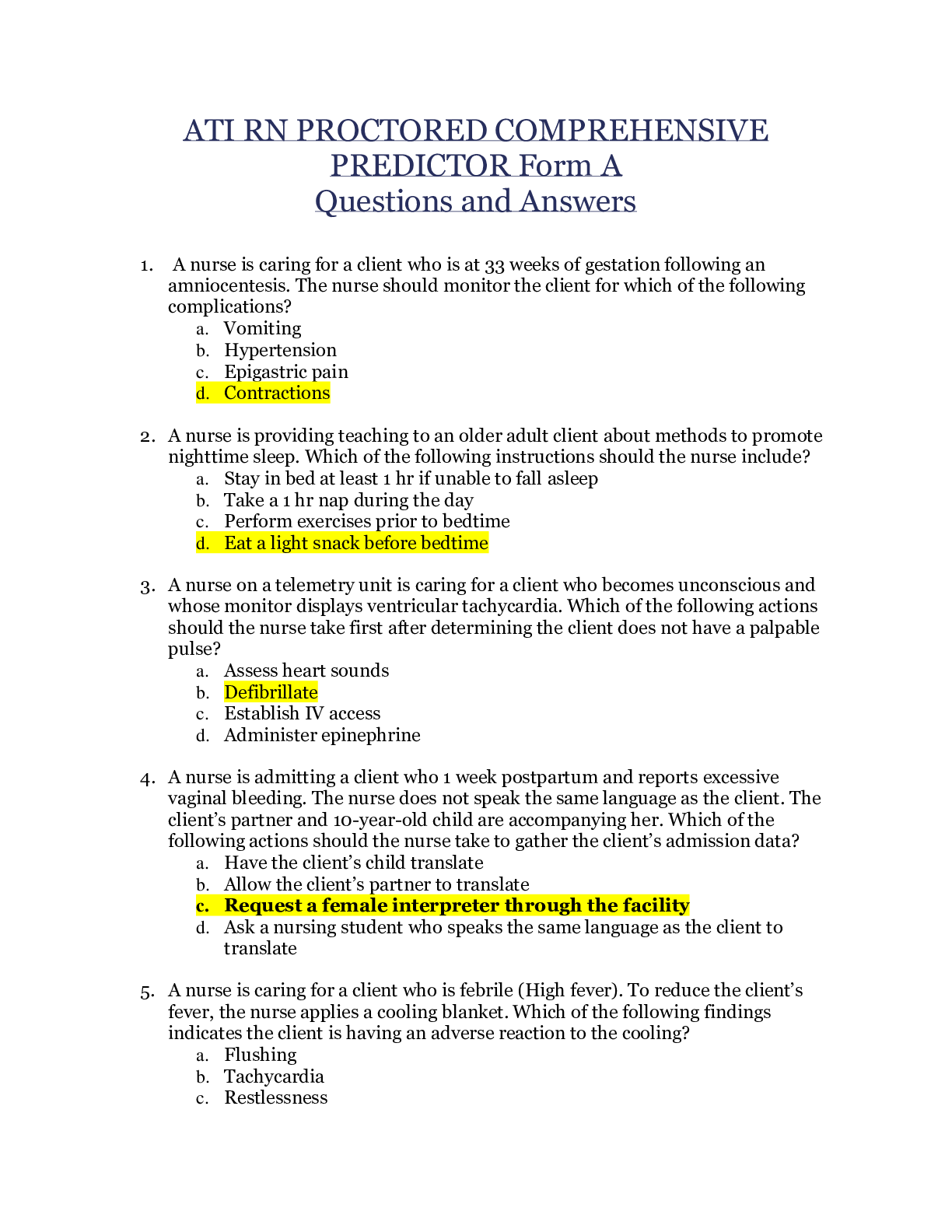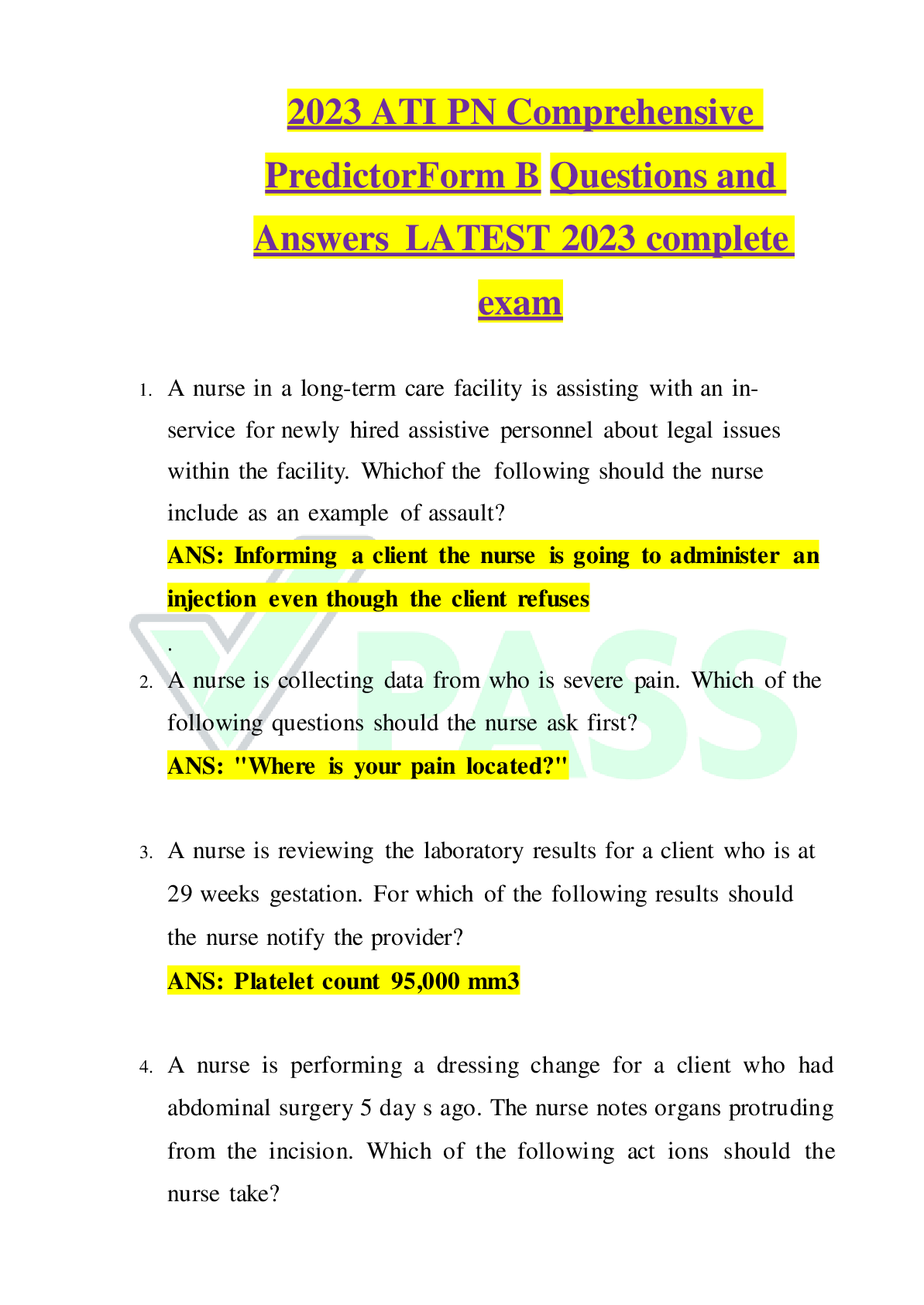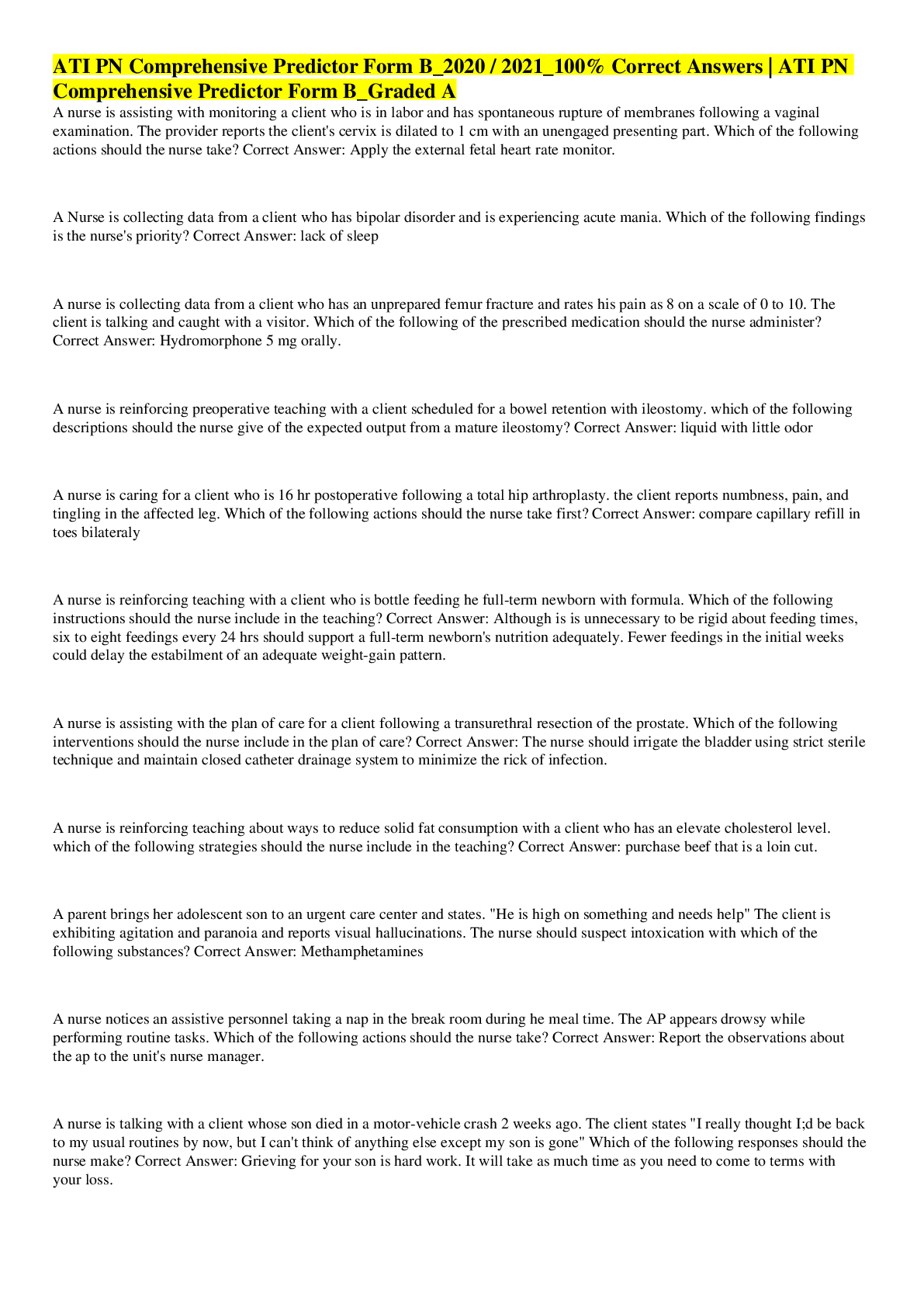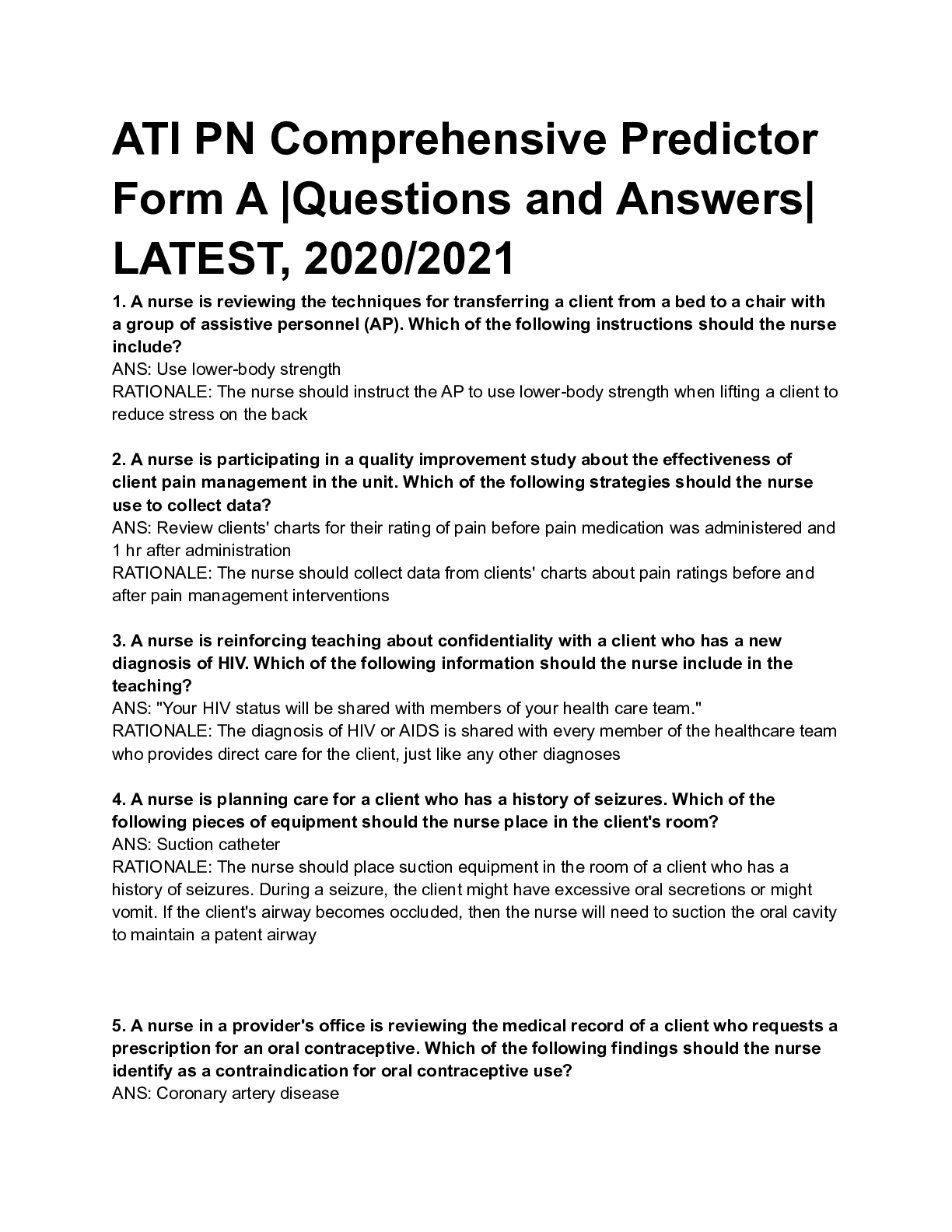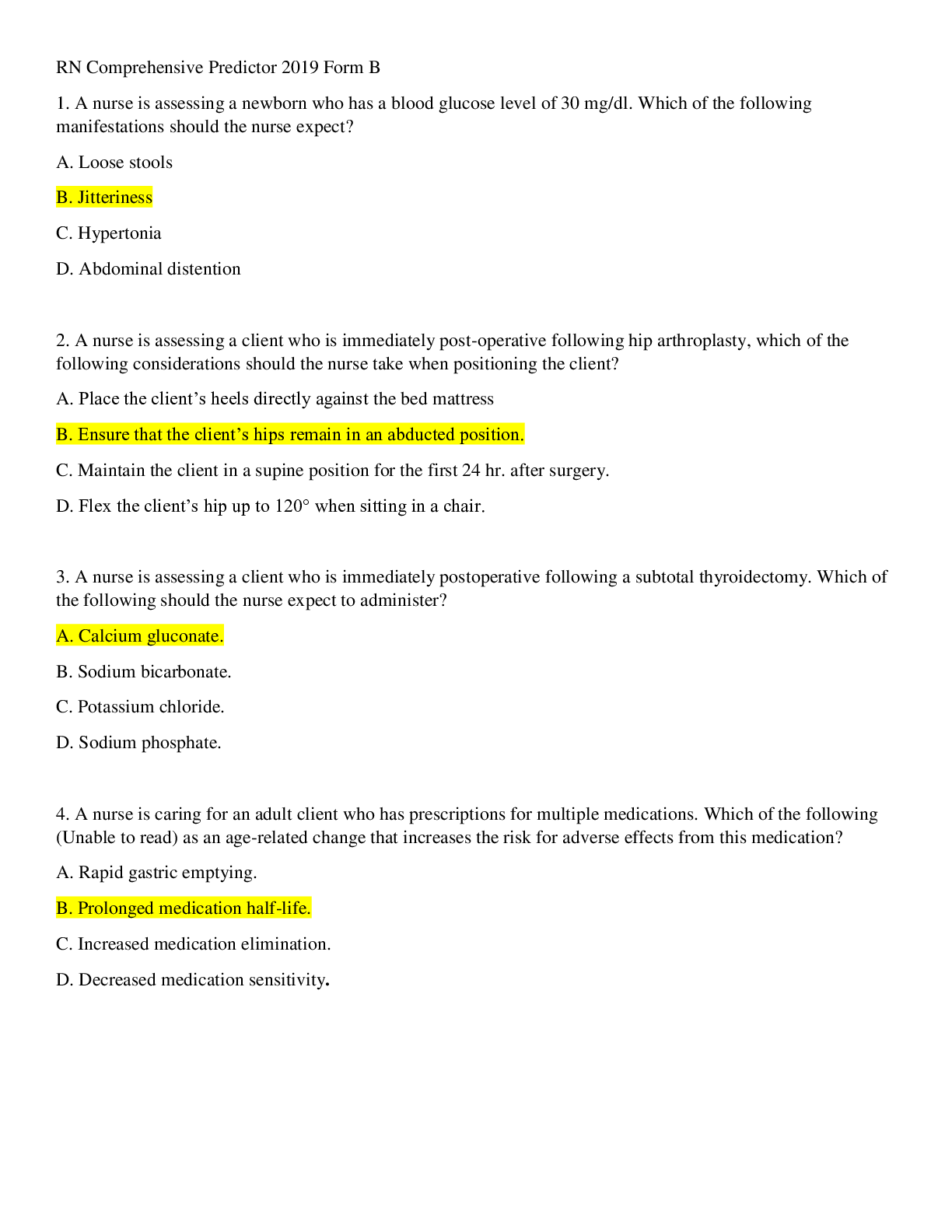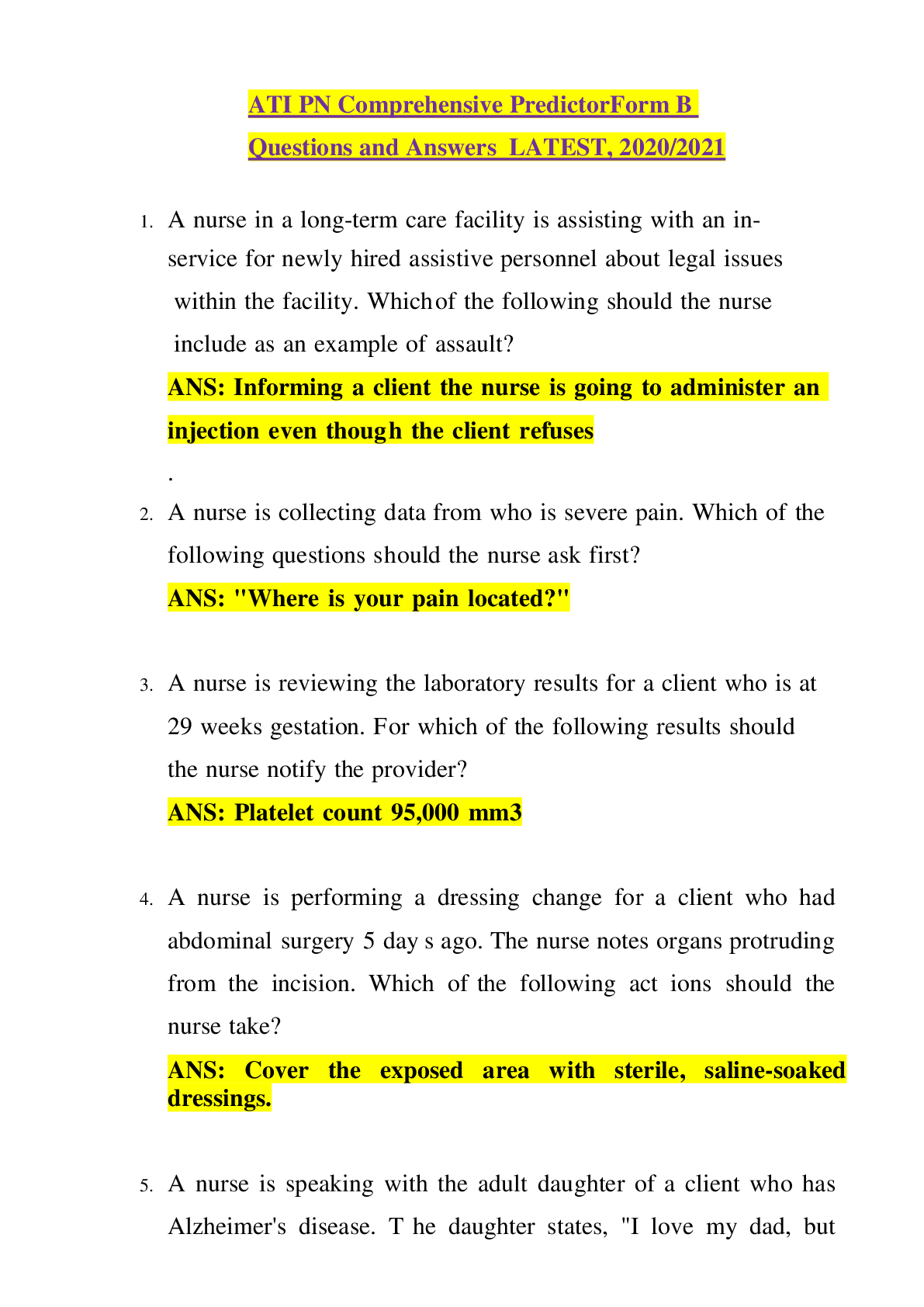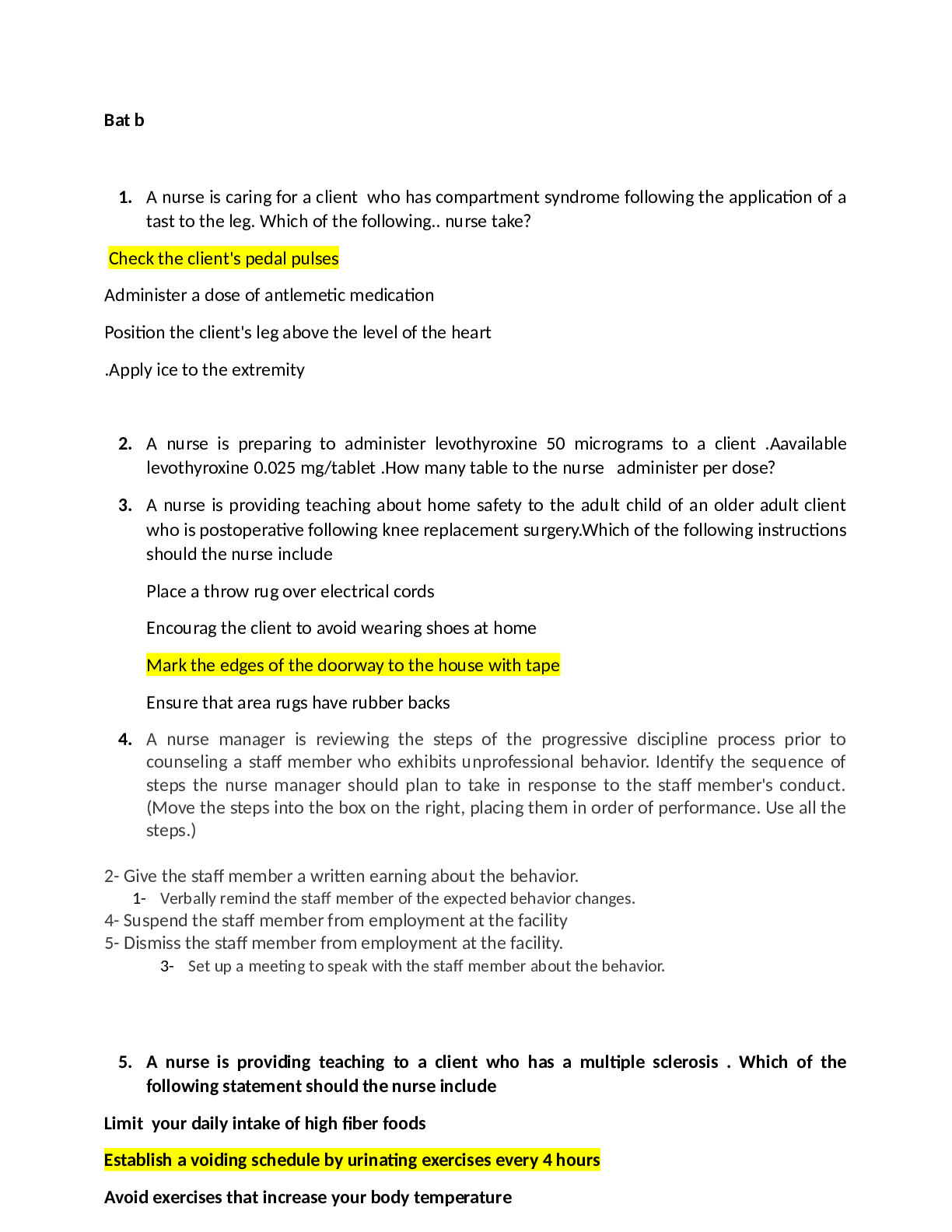Health Care > EXAM > ATI PN Comprehensive Predictor Form A |Questions and Answers| LATEST, 2020/2021 (All)
ATI PN Comprehensive Predictor Form A |Questions and Answers| LATEST, 2020/2021
Document Content and Description Below
ATI PN Comprehensive Predictor Form A |Questions and Answers| LATEST, 2020/2021 1. A nurse is reviewing the techniques for transferring a client from a bed to a chair with a group of assistive per... sonnel (AP). Which of the following instructions should the nurse include? ANS: Use lower-body strength RATIONALE: The nurse should instruct the AP to use lower-body strength when lifting a client to reduce stress on the back 2. A nurse is participating in a quality improvement study about the effectiveness of client pain management in the unit. Which of the following strategies should the nurse use to collect data? ANS: Review clients' charts for their rating of pain before pain medication was administered and 1 hr after administration RATIONALE: The nurse should collect data from clients' charts about pain ratings before and after pain management interventions 3. A nurse is reinforcing teaching about confidentiality with a client who has a new diagnosis of HIV. Which of the following information should the nurse include in the teaching? ANS: "Your HIV status will be shared with members of your health care team." RATIONALE: The diagnosis of HIV or AIDS is shared with every member of the healthcare team who provides direct care for the client, just like any other diagnoses 4. A nurse is planning care for a client who has a history of seizures. Which of the following pieces of equipment should the nurse place in the client's room? ANS: Suction catheter RATIONALE: The nurse should place suction equipment in the room of a client who has a history of seizures. During a seizure, the client might have excessive oral secretions or might vomit. If the client's airway becomes occluded, then the nurse will need to suction the oral cavity to maintain a patent airway 5. A nurse in a provider's office is reviewing the medical record of a client who requests a prescription for an oral contraceptive. Which of the following findings should the nurse identify as a contraindication for oral contraceptive use? ANS: Coronary artery disease RATIONALE: Coronary artery disease is a contraindication to oral contraceptive use because it increases the client's risk for myocardial infarction. Other contraindications for receiving oral contraceptives include gallbladder disease, breast cancer, and hypertension\ 6. A nurse is assisting with the care of a school-age child immediately following surgery. The child weighs 21.8 kg (48 lb) and has a chest tube applied to suction. Which of the following findings should the nurse report to the provider? ANS: 250 mL of sanguineous drainage over the last 3 hr RATIONALE: The nurse should recognize that if more than 3 mL/kg/her of sanguineous drainage occurs for more than 3 consecutive hours following surgery, it can indicate active hemorrhaging. Therefore, 250 mL of sanguineous drainage from the child's chest tube is excessive and the nurse should report this finding to the provider immediately 7. A nurse is collecting data from a client who is at 30 weeks of gestation and has gestational diabetes. Which of the following findings should the nurse report to the provider as an indication of hyperglycemia? ANS: Polyuria RATIONALE: The nurse should identify polyuria as an expected finding of hyperglycemia and report this finding to the provider 8. A nurse is discussing home safety with a group of clients who have type 1 diabetes mellitus. Which of the following client statements indicates an understanding of the teaching? ANS: "I will dispose of my needles in a plastic laundry detergent container." RATIONALE: The nurse should instruct the client to dispose of needles in a puncture-proof container, such as a plastic laundry detergent container. 9. A nurse is caring for a client who has Alzheimer's disease. Which of the following actions should the nurse take? ANS: Encourage the client to reminisce about the past RATIONALE: The client who has Alzheimer's disease has progressive loss of short-term memory and might not be able to recall recent happenings and events. This can lead to increased frustration. However, remote memory remains in place for a longer period of time and can elicit feelings of happiness 10. A nurse is monitoring a client who is receiving telemetry. Which of the following ECG findings should the nurse report to the provider? ANS: PR interval 0.24 seconds RATIONALE: An expected PR interval is 0.12 to 0.20 seconds. A prolonged PR interval indicates a heart block; therefore, the nurse should report this finding provider 11. A nurse on a medical unit is reviewing a client's medical record. Which of the following procedures should the nurse identify requires the client to sign a separate informed consent form? ANS: Lumbar puncture RATIONALE: The nurse should identify that a client needs to provide consent for general treatment, as well as a separate written, informed consent for any treatment that has an element of risk, such as a lumbar puncture 12. A licensed practical nurse (LPN) is reviewing client assignments for the upcoming shift. Which of the following clients should the LPN ask the charge nurse to reassign to a registered nurse (RN)? ANS: A client who has a new colostomy and requires the development of a teaching plan RATIONALE: Developing a client teaching plan is not within the scope of practice for an LPN. The nurse should contact the nursing supervisor to inform them of the client's need for a teaching plan regarding the new colostomy and request that this client is reassigned to an RN. The scope of practice of an LPN does allow the nurse to reinforce teaching once the plan has been established 13. A nurse is caring for a client who is recovering from a stroke and is experiencing difficulty using eating utensils. The nurse should identify the need for a referral to one of the following interprofessional team members? ANS: Occupational therapist RATIONALE: The nurse should identify the need for a referral to an occupational therapist to teach the client how to use special eating utensils 14. A nurse is preparing to perform blood glucose monitoring for a client who has type 1diabetes Mellitus. Which of the following actions should the nurse take first? ANS: Hold the finger for testing in a dependent position RATIONALE: Evidence-based practice indicates that the nurse should first position the testing site to enhance blood flow, which improves the ability to collect an adequate specimen 15. A home health nurse is reinforcing teaching with a client about the use of elastic stockings to decrease peripheral edema. Which of the following instructions should the nurse include? ANS: Apply the stockings in the morning RATIONALE: The nurse should instruct the client to apply the elastic stockings in the morning and remove them at the end of the day before bedtime 16.A nurse in a provider's office is reviewing pediculosis capitis management and prevention strategies with the parent of a school-age child. Which of the following strategies should the nurse include? (Select all that apply.) ANS: Store the child's clothing in a separate cubicle when at school. Boil brushes and combs in water for 10 min. Dry bed linens and clothing in a hot dryer for at least 20 min. RATIONALE: Transmission of lice occurs via contact with personal items. Boiling hair care items in hot water for 10 min kills lice and nits. Exposing bedding and clothing to prolonged heat by washing in hot dryer for at least 20 min is an appropriate strategy 17. A nurse is contributing to the plan of care for a client who has a continent urinary diversion. Which of the following interventions should the nurse plan to implement to facilitate urinary elimination? ANS: Use intermittent urinary catheterization for the client on at regular intervals RATIONALE: A continent urinary diversion contains valves that prevent urine from exiting the pouch; therefore, the nurse should plan to insert a urinary catheter at regular intervals to drain urine from the client's pouch. 18. A nurse is preparing to perform a bladder scan for a client. Which of the following actions should the nurse take? ANS: Tell the client they should not experience any discomfort RATIONALE: The nurse applies the handheld scanner over the area of the bladder when performing a bladder scan. This noninvasive procedure should not cause the client any discomfort 19. A nurse is caring for a client who is crying and states that their provider informed them that they have a tumor and will need a biopsy. Which of the following responses should the nurse make? ANS: "What have you done to help yourself get through stressful situations before?" RATIONALE: This is a therapeutic response. The nurse is aware that the client is under stress and encourages comparison to investigate whether they have experience dealing with a stressful situation 20. A nurse is caring for a newborn who is 12 hr old. The nurse should expect the newborn's stool to have which of the following characteristics within the first 24 hour following birth? ANS: Dark greenish-black and viscous RATIONALE: The first stool passed by a newborn is the meconium that develops in utero. It is dark greenish-black and viscous, containing of amniotic fluid, cells, intestinal secretions, and blood 21.A licensed practical nurse is assisting with the preparation of a client for insertion of a peripherally inserted central venous catheter (PICC). Which of the following actions should the nurse take? ANS: Witness the client's signature on the informed consent form. RATIONALE: The insertion of a PICC is an invasive procedure with risks and benefits. The nurse should witness the client's signature on the consent form after ensuring the client has an understanding of the procedure, including its risks and benefits 22.A nurse is caring for a client who adheres to a kosher diet. Which of the following food selections should the nurse expect to see on the client's meal tray? ANS: Spaghetti noodles with red sauce RATIONALE: The nurse should identify that spaghetti noodles with red sauce is appropriate for a client who adheres to a kosher diet. 23.A nurse is contributing to the plan of care for a client who is receiving continuous bladder irrigation following a transurethral resection of the prostate (TURP). Which of the following interventions should the nurse include? ANS: Maintain a drainage flow rate to keep the urine diluted to a reddish-pink color RATIONALE: The nurse should maintain the flow rate of the bladder irrigation to keep the urine diluted to a reddish-pink color and the tubing free of clots and bleeding 24. A nurse is assisting with the care of a client who is postpartum and has a deep-vein thrombosis. The client has been receiving heparin IV infusion. Which of the f [Show More]
Last updated: 1 year ago
Preview 1 out of 81 pages
Instant download
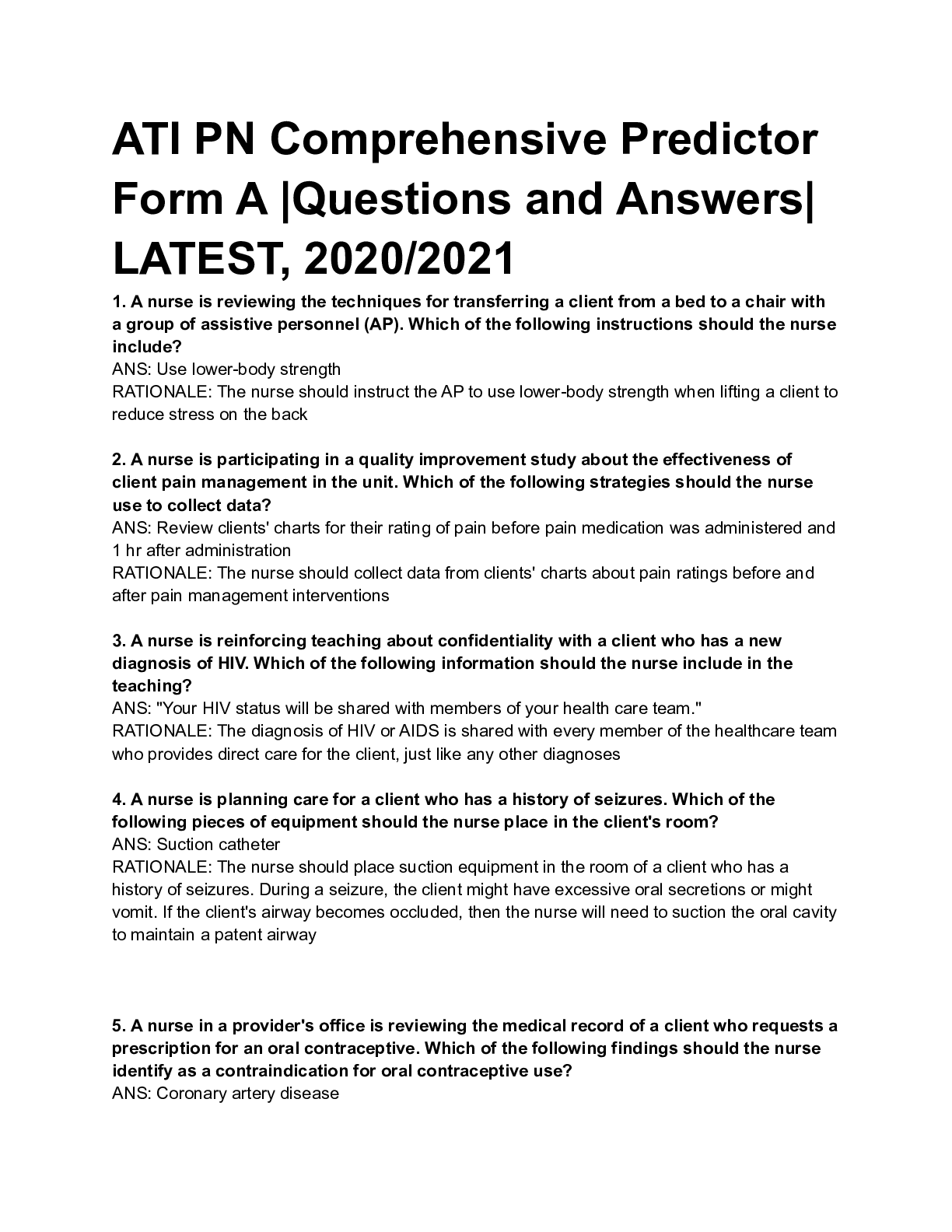
Instant download
Reviews( 0 )
Document information
Connected school, study & course
About the document
Uploaded On
Aug 18, 2022
Number of pages
81
Written in
Additional information
This document has been written for:
Uploaded
Aug 18, 2022
Downloads
0
Views
28

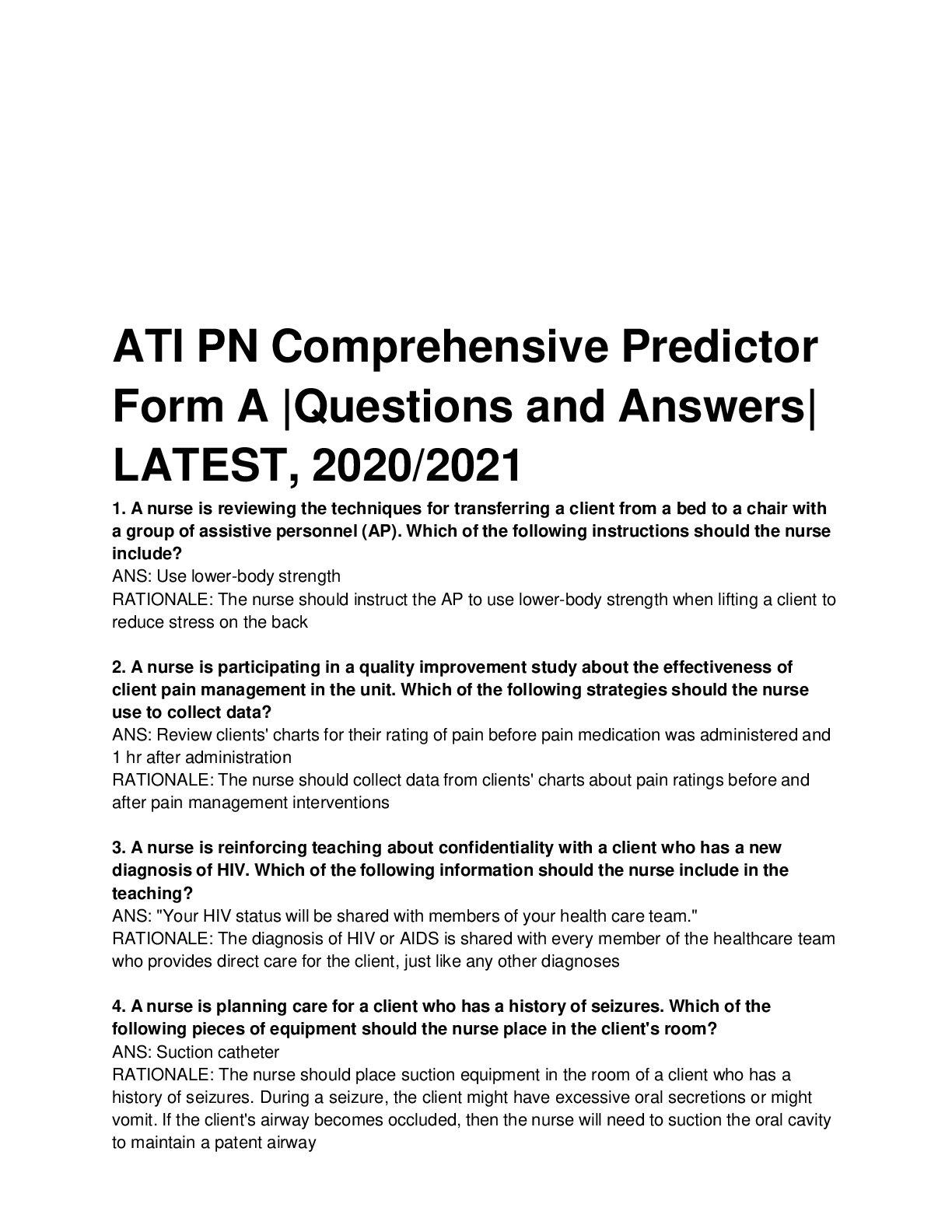
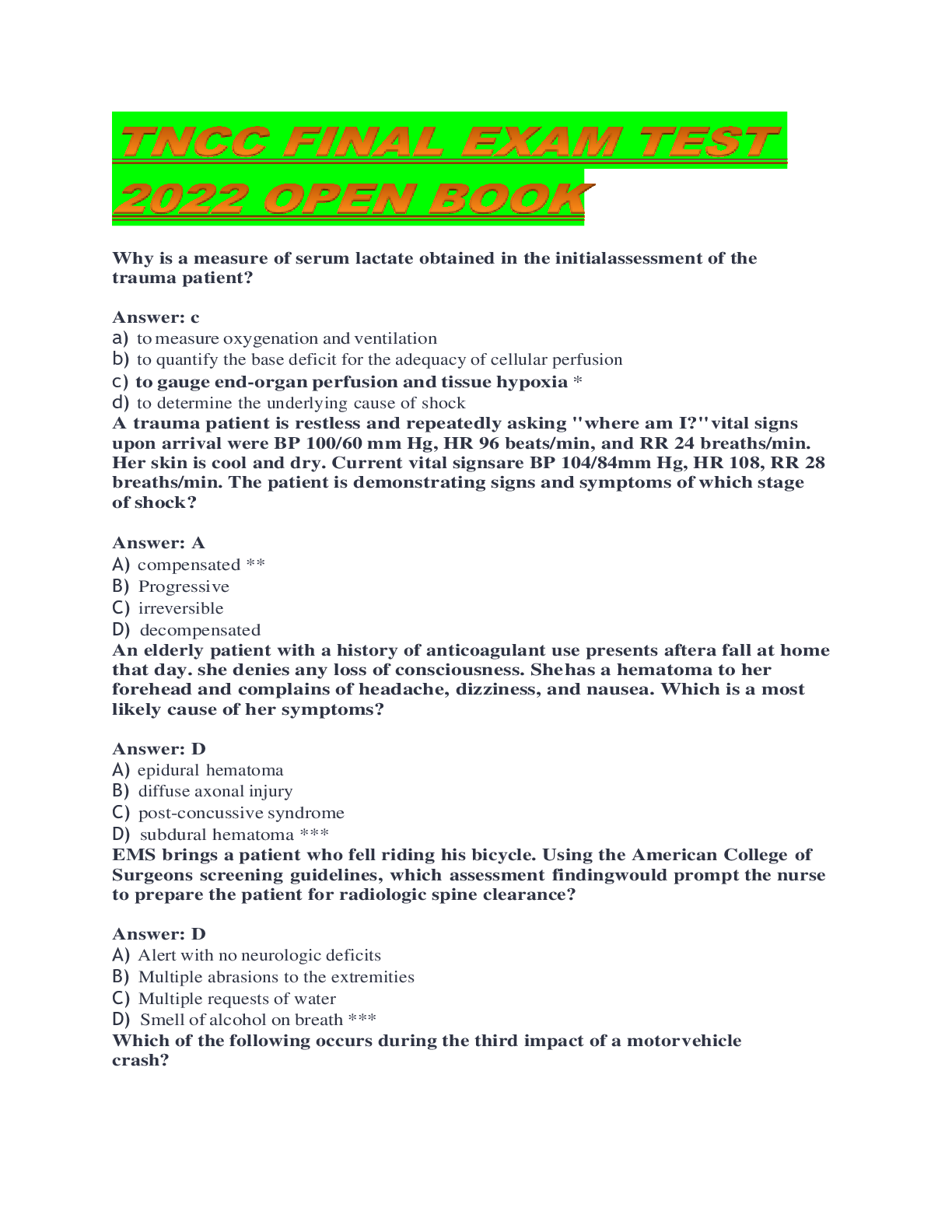
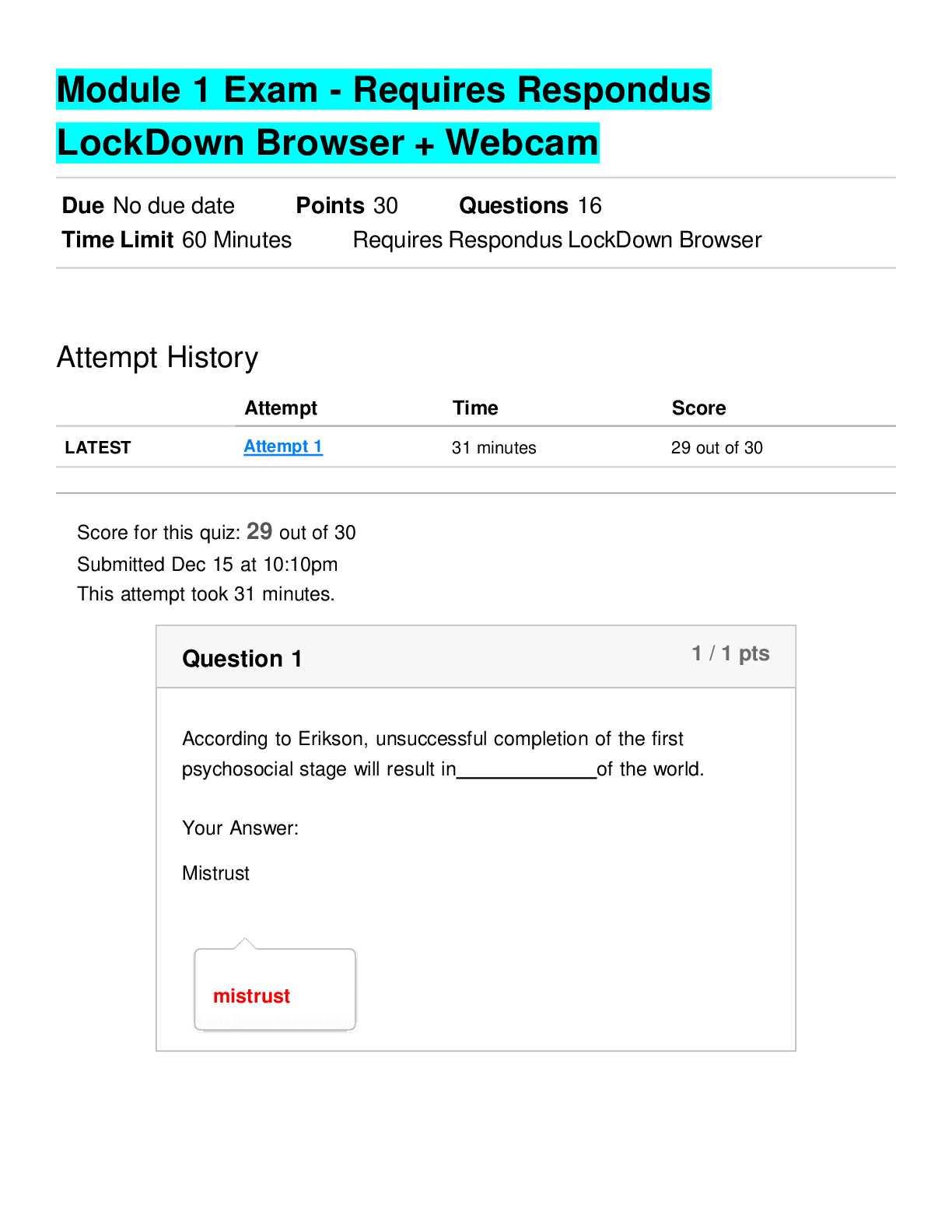
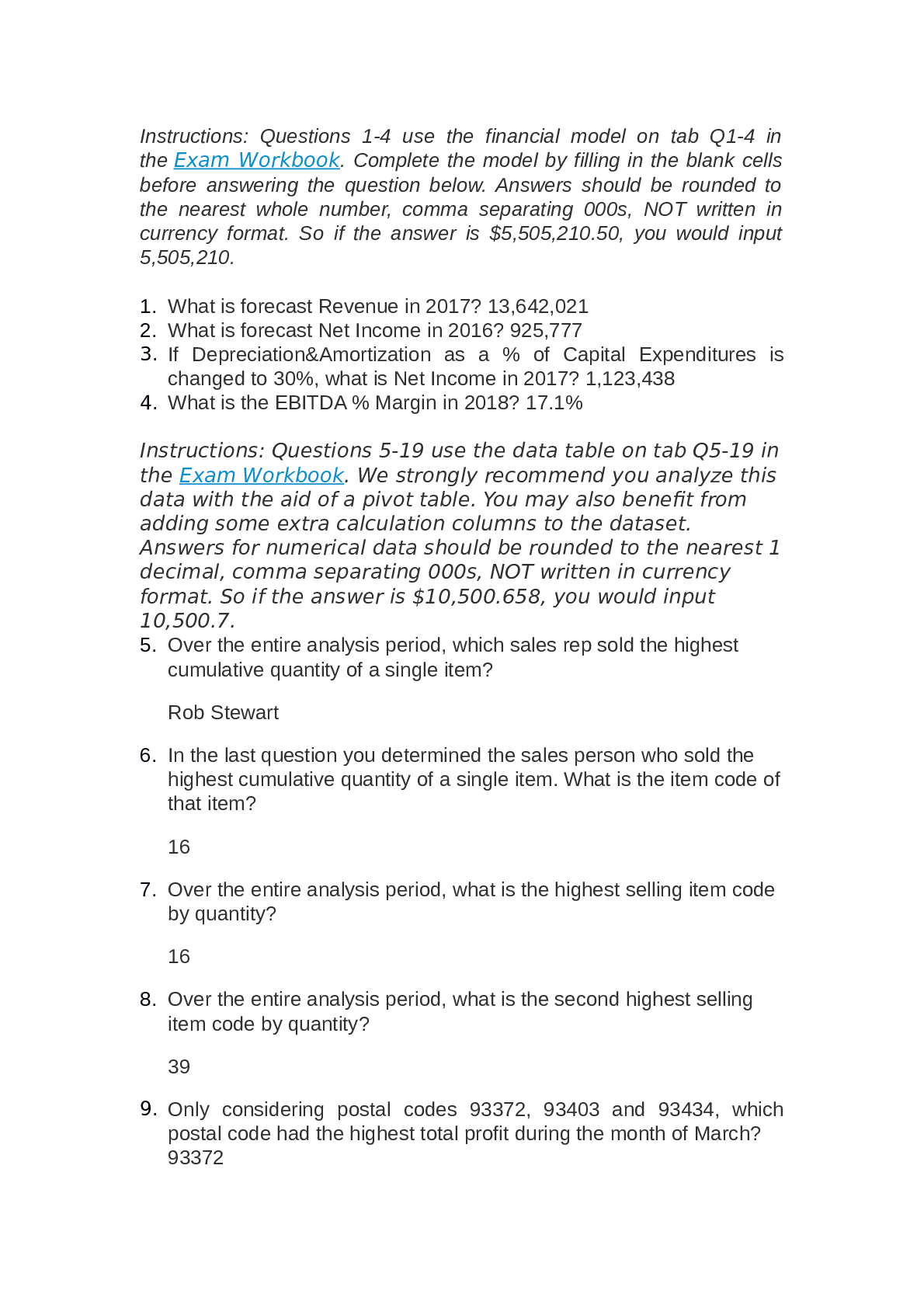
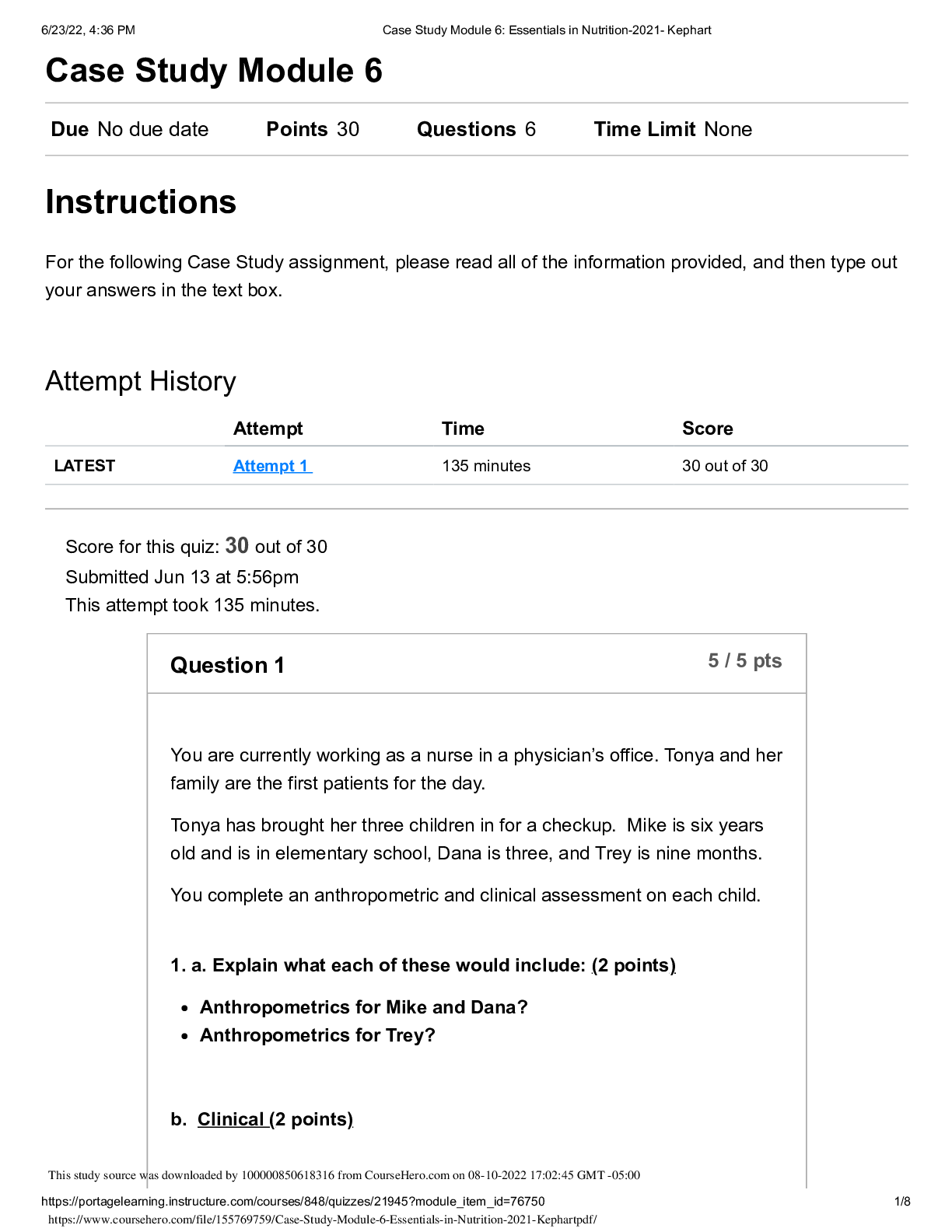
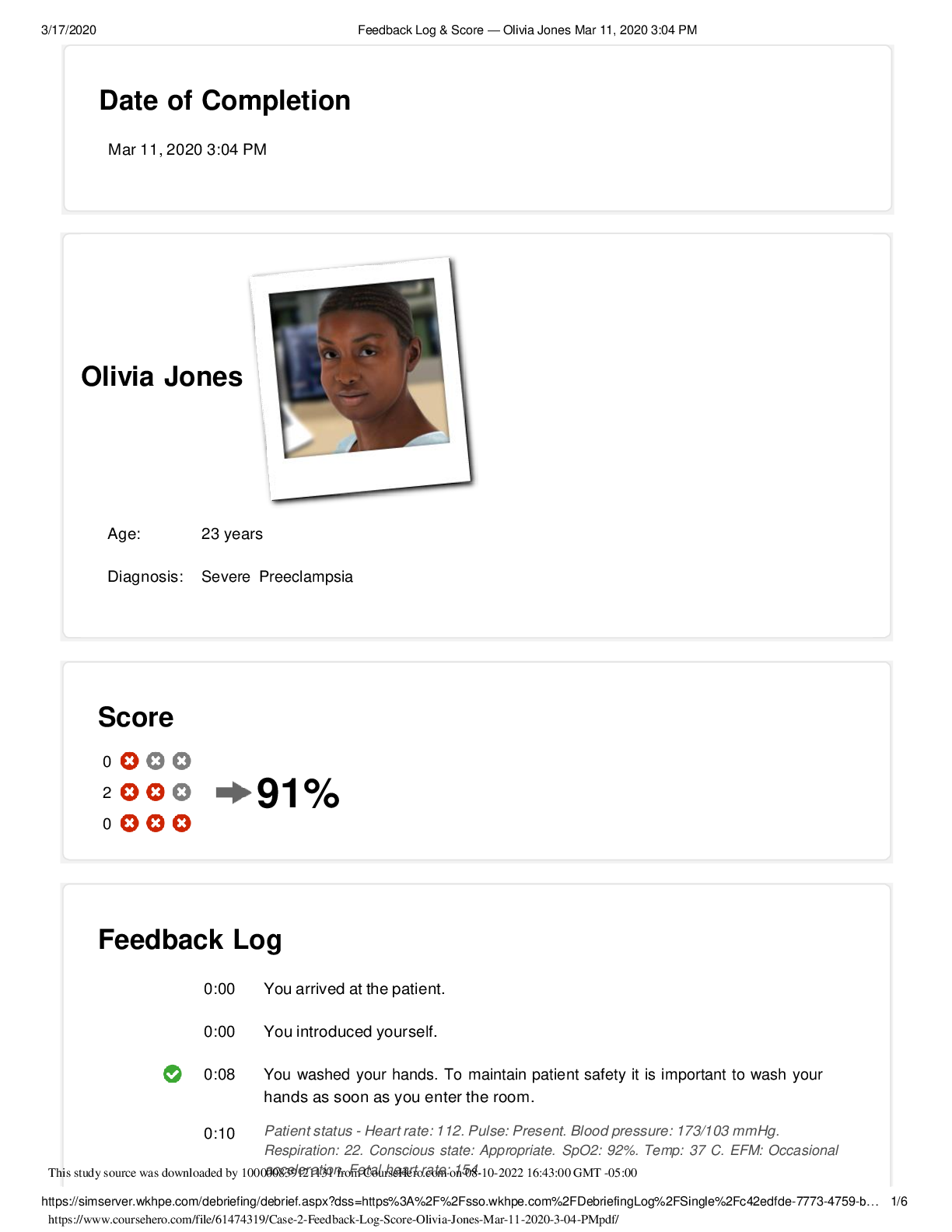
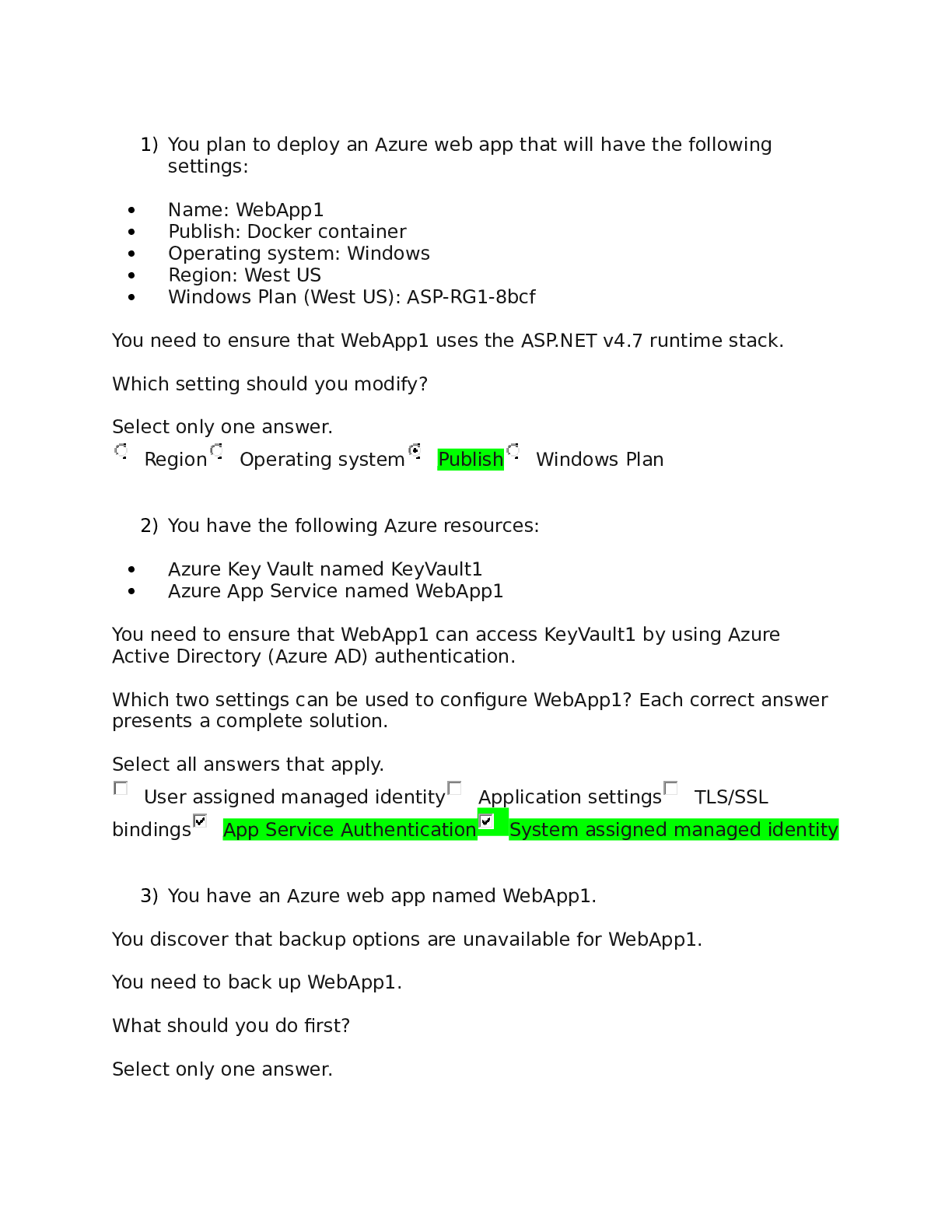

pdf (1).png)
